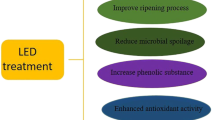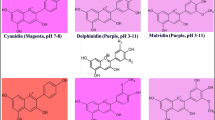Abstract
Persimmon (Diospyros kaki L.), belonging to the Ebenaceae family, has been used not only as a fresh fruit, but also for many medicinal uses. Carotenoids are the main pigment in persimmon fruit, which contribute significantly to fruit color and nutritional quality due to their composition and content. In this study, fruit quality indices, carotenoid contents and expression of carotenogenic genes were analyzed in two types of persimmon fruit. The results demonstrated that there was a positive correlation between fruit color and the contents of main composition and total carotenoids. Carotenoid accumulation in persimmon fruit resulted from the interaction of carotenogenic genes, but the molecular mechanisms responsible for accumulation of carotenoids in two types of persimmon fruit had a few differences. As a complete unit, the relatively low expression level of phytoene synthase gene (DkPSY) in “Niuxinshi” resulted in low carotenoid contents or even under the detection limit at the early fruit developmental stages; but low carotenoid contents in “Nishimurawase” were due to the relatively low expression level of carotenogenic genes other than DkPSY. At the late fruit developmental stages, increased expression levels of DkPSY, phytoene desaturase gene and beta-carotene hydroxylase gene (DkBCH) induced elevated carotenoid contents; because all carotenogenic genes strongly expressed in “Nishimurawase”, a large amount of carotenoids were accumulated. In addition, β-cryptoxanthin was the main composition whose content increased with the fruit maturity changes, which was mainly because of DkBCH which might lead more conversion of β-carotene to β-cryptoxanthin.




Similar content being viewed by others
Abbreviations
- BCH:
-
Beta-carotene hydroxylase
- Ct:
-
Threshold cycle
- LCYB:
-
Lycopene beta-cyclase
- LCYE:
-
Lycopene ε-cyclase
- PCR:
-
Polymerase chain reaction
- PDS:
-
Phytoene desaturase
- PSY:
-
Phytoene synthase
- Q-PCR:
-
Quantitative real-time PCR
- RT-PCR:
-
Reverse-transcription polymerase chain reaction
- ZEP:
-
Zeaxanthin epoxidase
- ZDS:
-
ζ-Carotene desaturase
- HPLC:
-
High-performance liquid chromatography
References
Achiwa Y, Hibasami H, Katsuzaki H, Imai K, Komiya T (1997) Inhibitory effects of persimmon (Diospyros kaki) extract and related polyphenol compounds on growth of human lymphoid leukemia cells. Biosci Biotechnol Biochem 61(7):1099–1101
Ahn HS, Jeon TI, Lee JY, Hwang SG, Lim Y, Park DK (2002) Antioxidative activity of persimmon and grape seed extract: in vitro and in vivo. Nutr Res 22:1265–1273
Bartley GE, Scolnik PA (1995) Plant carotenoids: pigments for photoprotection, visual attraction, and human health. Plant Cell 7(7):1027–1038
Crisosto CH, Garner D, Crisosto GM, Sibbett S, Day KR (1994) Late harvest and delayed cooling induce internal browning of ‘Ya Li’ and ‘Seuri’ Chinese pears. HortScience 29:667–670
Cunningham FX, Gantt E (1998) Genes and enzymes of carotenoid biosynthesis in plants. Annu Rev Plant Physiol Plant Mol Biol 49:557–583
Ebert G, Gross J (1985) Carotenoid changes in the peel of ripening persimmon (Diospyros kaki) cv. Triumph Phytochem 24:29–32
Feng J, Chen X, Wu Y, Liu W, Liang Q, Zhang L (2006) Detection and transcript expression of S-RNase gene associated with self-incompatibility in apricot (Prunus armeniaca L.). Mol Biol Rep 33:215–221
Food and Agriculture Organization (FAO) (2010) http://faostat.fao.org/site/567/DesktopDefault.aspx?PageID=567#ancor, accessed 02 September 2010
Fraser PD, Bramley PM (2004) The biosynthesis and nutritional uses of carotenoids. Prog Lipid Res 43:228–265
Fukuda T, Shibata H (1994) Persimmon calyx extracts as anticonvulsants and to alleviate the side effects of barbituric acid compounds. Patent Jpn Kokai Tokkyo Koho 6:649
Galpaz N, Ronen G, Kehava Z, Zamir D, Hirschberg J (2006) A chromoplast-specific carotenoid biosynthetic pathway is revealed by cloning of the tomato white-flower locus. Plant Cell 18:1947–1960
Gorinstein S, Zachwieja Z, Folta M, Barton H, Piotrowicz J, Zemser M (2001) Comparative contents of dietary fiber, total phenolics, and minerals in persimmons and apples. J Agric Food Chem 49(2):952–957
Gross J, Bazak H, Blumenfeld A, Ben-Arie R (1984) Changes in chlorophyll and carotenoid pigments in the peel of ‘Triumph’ persimmon (Diospyros kaki L.) induced by pre-harvest gibberellin (GA3) treatment. Sci Hortic 24(3–4):305–314
Hughes DA (2001) Dietary carotenoids and human immune function. Nutrition 17:823–827
Intelmann D, Jaros D, Rohm H (2005) Identification of color optima of commercial tomato catsup. Eur Food Res Technol 22:662–666
Ito M, Yamano Y, Tode C, Wada A (2009) Carotenoid synthesis: retrospect and recent progress. Arch Biochem Biophys 483(2):224–228
Kato M, Ikoma Y, Matsumoto H, Sugiura M, Hyodo H, Yano M (2004) Accumulation of carotenoids and expression of carotenoid biosynthetic genes during maturation in citrus fruit. Plant Physiol 134:824–837
Kawase M, Motohashi N, Satoh K, Sakagami H, Nakashima H (2003) Biological activity of persimmon (Diospyros kaki) peel extracts. Phytother Res 17(5):495–500
Kudritskaya SE, Fishman GM, Chikovani DM (1984) Carotenoids of the fruit of the subtropical persimmon, variety khachia. Chem Nat Compd 20:369
Li MJ, Liang D, Pu F, Ma FW, Hou CM, Lu T (2009) Ascorbate levels and the activity of key enzymes in ascorbate biosynthesis and recycling in the leaves of 22 Chinese persimmon cultivars. Sci Hortic 120:250–256
Ma C, Ma B, He J, Hao Q, Lu X, Wang L (2010) Regulation of carotenoid content in tomato by silencing of lycopene β/ε-Cyclase genes. Plant Mol Biol Report. doi:10.1007/s11105-010-0211-3
Matsuno T (1991) XanthoPhylls as precursors of retinoids. Pure Appl Chem 63:81–88
McGuire RG (1992) Reporting of objective colour measurements. HortScience 27:1254–1255
Miki W (1991) Biological functions and activities of animal carotenoids. Pure Appl Chem 63(1):141–146
Nagao A (2009) Absorption and function of dietary carotenoids. Food Factors Health Promot 61:55–63
Nakagawa T, Nakatsuka A, Yano K, Yasugahira S, Nakamura R, Sun N, Itai A, Suzuki T, Itamura H (2008) Expressed sequence tags from persimmon at different developmental stages. Plant Cell Rep 27:931–938
Niikawa T, Suzuki T, Ozeki T, Kato M, Ikoma Y (2007) Characteristics of carotenoid accumulation during maturation of the Japanese persimmon ‘Fuyu’. Hortic Res Jpn 6(2):251–256, In Japanese
Qi J, Yu S, Zhang F, Shen X, Zhao X, Yu Y, Zhang D (2010) Reference gene selection for real-time quantitative polymerase chain reaction of Mrna transcript levels in Chinese cabbage (Brassica rapa L.ssp. pekinensis). Plant Mol Biol Report 28:597–604
Robert V, Jana J, Maja MP, Franci S, Valentina S (2010) Comparative study of primary and secondary metabolites in 11 cultivars of persimmon fruit (Diospyros kaki L.). Food Chem 119:477–483
Rock CL (1997) Carotenoids: biology and treatment. Pharmacol Ther 75(3):185–197
Rodrigo M, Marcos JF, Zacarías L (2004) Biochemical and molecular analysis of carotenoid biosynthesis in flavedo of orange (Citrus sinensis L.) during fruit development and maturation. J Agric Food Chem 52:6724–6731
Rodríguez-Ávila NL, Narváez-Zapata JA, Aguilar-Espinosa M, Rivera-Madrid R (2010) Regulation of pigment-related genes during flower and fruit development of Bixa orellana. Plant Mol Biol Report. doi:10.1007/s11105-010-0207-z
Ronen G, Cohen M, Zamir D, Hirschberg J (1999) Regulation of carotenoid biosynthesis during tomato fruit development: expression of the gene for lycopene epsilon-cyclase is down-regulated during ripening and is elevated in the mutant Delta. Plant J 17:341–351
Sakanaka S, Tachibana Y, Okada Y (2005) Preparation and antioxidant properties of extracts of Japanese persimmon leaf tea (Kakinohacha). Food Chem 89:569–575
Schieber A, Carle R (2005) Occurrence of carotenoid cis-isomers in food: technological, analytical, and nutritional implications. Trends Food Sci Technol 16:416–422
Shela G, Elzbieta B, Gustaw K, Marina Z, Simon T (1998) Dietary persimmon improves lipid metabolism in rats fed diets containing cholesterol. J Nutr 128(11):2023–2027
Sun J, Zhang YY, Liu H, Zou Z, Zhang CJ, Zhang XH, Li HX, Ye ZB (2010) A novel cytoplasmic isopentenyl diphosphate isomerase gene from tomato (Solanum lycopersicum): cloning, expression, and color complementation. Plant Mol Biol Report 28:473–480
Tao J, Zhang SL (2003) Metabolism of carotenoid and its regulation in garden crop. J Zhejiang Univ Agric Life Sci Editon 29:585–590 (in Chinese)
Tao J, Zhang SL, Xu CJ, An XM, Zhang SL (2002) Gene and gene engineering of carotenoid biosynthesis. Chin J Biotechnol 18(3):276–281, In Chinese
Thomas P, Chen TS (1998) Quantitative analyses of major carotenoid fatty acid esters in fruits by liquid chromatography: persimmon and papaya. Food Sci 53(6):1720–1722
Voss DH (1992) Relating colourimeter measurement of plant colour to the Royal Horticultural Society colour chart. HortScience 27:1256–1260
Xu CJ, Chen KS, Zhang B, Wang QJ, Ye WJ (2004) A study on methods for RNA extraction from Citrus tissues. J Fruit Sci 21:136–140, in Chinese
Xu CJ, Fraser PD, Wang WJ, Bramley PM (2006) Differences in the carotenoid content of ordinary citrus and lycopene-accumulating mutants. J Agric Food Chem 54:5474–5481
Xu CJ, Zhang SL (2000) Carotenoid biosynthesis and its regulation in plants. Plant Physiol Commun 36(1):64–70
Yonemori K, Sugiura A, Yamada M (2000) Persimmon genetics and breeding. Plant Breed Rev 19:191–225
Yuan B, Xu HL, Leng P (2006) Content and chemical composition of carotenoids in persimmon fruit. Chin Agric Sci Bull 22:277–280 (in Chinese)
Zhao D, Zhou C, Sheng Y, Liang G, Tao J (2010) Molecular cloning and expression of phytoene synthase, lycopene beta-cyclase, and beta-carotene hydroxylase genes in persimmon (Diospyros kaki L.) Fruits. Plant Mol Biol Report. doi:10.1007/s11105-010-0238-5
Zhou CH, Xu CJ, Li X, Sun CD, Chen KS (2007) Carotenoids in white and red-fleshed loquat fruits. J Agric Food Chem 55:7822–7830
Acknowledgements
This work was financially supported by the Natural Science Foundation of China (30771491), China Postdoctoral Science Foundation (20100471401) and Postdoctoral Science Foundation of Jiangsu Province (0901055C).
Author information
Authors and Affiliations
Corresponding author
Rights and permissions
About this article
Cite this article
Zhao, D., Zhou, C. & Tao, J. Carotenoid Accumulation and Carotenogenic Genes Expression During Two Types of Persimmon Fruit (Diospyros kaki L.) Development. Plant Mol Biol Rep 29, 646–654 (2011). https://doi.org/10.1007/s11105-010-0272-3
Published:
Issue Date:
DOI: https://doi.org/10.1007/s11105-010-0272-3




